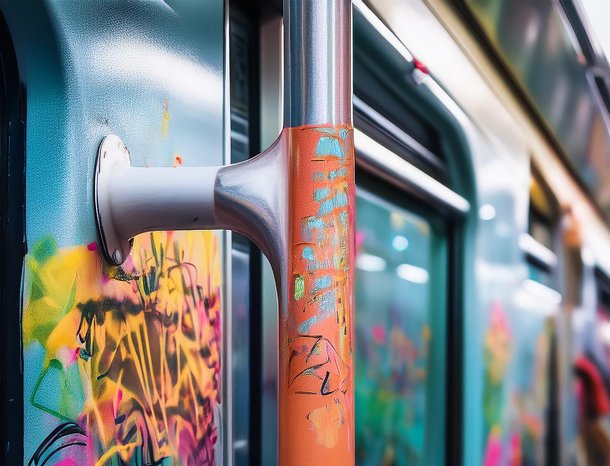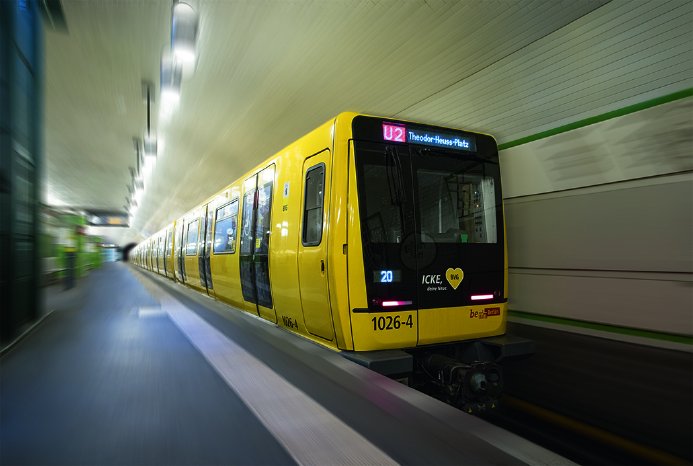12.1 million euro: That is how much graffiti damage cost Deutsche Bahn in 2022. No less than one sixth of this figure was incurred by regional and suburban trains in Berlin and Brandenburg. And Berliner Verkehrsgesellschaft (BVG) is also very familiar indeed with this problem: Each year, the damage caused by vandalism amounts to between four and five million euro, of which one million euro is due to graffiti. “Graffiti appears on floors, walls, interior components and, most especially, in train toilets. Another significant topic goes by the name of scratching”, reports Dr. Christian Bohne, the Head of Surface and Joining Technology at DB Systemtechnik (DBS) in Brandenburg-Kirchmöserder. Deutsche Bahn, BVG and many other rail operators are now using video surveillance in trains to an increasing extent in an effort to deter and identify perpetrators. In addition, films or coatings are being applied at railway stations, protective films are being applied to window glass and rolling stock is being equipped with transparent protective coatings. Those coatings are intended to make it easier to remove graffiti and what are known as ‘tags’ – lettering applied using thick fibre markers.
Great durability, easy to clean
These protective coatings have two tasks to perform at the same time: They need to be resistant to the cleaning agents, some of which are very powerful, that are applied on a regular basis, while also making it easy to clean off graffiti and other unwanted marks. The quality requirements are very exacting indeed due to the extremely high stresses and strains to which components in trains or underground railways are subjected. “A service life of at least ten years is required for the durability of the surfaces, and the trains themselves must last up to 40 years,”, explains Dr. Hilmar Weisse, the Business Manager at FreiLacke.
Hardness test for surfaces
The interiors of underground and surface trains are cleaned on an almost daily basis, whereas it is usually sufficient for the exterior to get a weekly wash using the drive-through cleaning system. “The rule here is: The better the surface, the easier it is to remove graffiti. If the coating has open structures, it becomes difficult”, explains Bohne. To remove all the dirt quickly and effectively, operators use strong cleaning agents some of which can be aggressive. Graffiti always needs to be removed by hand and this is not possible in either a drive-through train wash or using cleaning machines. Train conductors therefore carry special cleaning cloths with them to wipe off graffiti immediately to the best of their ability. “Otherwise, a special graffiti remover is applied to the affected area, acting in a similar way to a typical paint stripper”, says Weisse: “A process that often has to be repeated several times. This is very strenuous for the employees due to the high level of physical effort and, unfortunately, this work is often also associated with health problems caused by solvent vapours”. The ‘artists’ are completely unaware of the amount of labour and cost they cause with their quickly scrawled tags and graffiti, leading to other people having to engage in a lot of hard work. The surfaces also suffer as a consequence of this remedial work, a harsh trial.
Qualification of coating systems
As a rail operator, Deutsche Bahn defines specific requirements for the coating of vehicles with which manufacturers such as Stadler, Siemens and Alstom are required to comply. For example, the DBS 918300 standard for liquid coatings and the DBS 918340 standard for powder coatings. Interior powder or liquid paint coatings in the passenger compartment must satisfy the specifications in Sheet 38 of these DBS standards. “Whenever we purchase powder-coated parts, their coatings must comply with the standards of DBS 918340. This directive stipulates how a powder coating is to be tested to ensure that it meets certain parameters in relation to the interior or exterior coating of technical or decorative components”, states surface expert Bohne.
The DBS qualifies the coating systems of the manufacturers and also makes recommendations within the railway industry. For example, whenever the rail operator purchases new ICE trains for long-distance routes, the DBS founds upon the technical specifications, defines up a coating plan and stipulates the quality level in accordance with DBS definitions. Furthermore, the DBS also makes recommendations in cases where a vehicle operator might require enhanced protection against graffiti.
Deutsche Bahn requirements satisfied
The list of DBS-qualified powder coatings currently (as of July 2024) includes a total of 61 coatings from various manufacturers. However, only one of these also satisfies the requirements of Sheet 50, ‘Technical Terms of Delivery for Coating Materials for Rail Vehicles’: the system coating derived from the Freiotherm PZ5 powder coating and the DC1983 liquid coating made by FreiLacke. The product qualification document issued by DB Systemtechnik states that ‘This product also satisfies the requirements in Sheet 50 of DBS 918300 in relation to barrier effect, resistance to cleaning agents, graffiti removal agents and the repeated removal of graffiti’. PZ5 and DC1983 do not soften or swell, crack, peel, leave behind ink residue or form ‘shadows. It is possible to remove graffiti on multiple occasions without leaving any residue or discolouration. Furthermore, additional layers of powder and liquid coatings can be applied without adhesion problems when repairing or touching up the paintwork.
Additional permanent protection is no longer required
“The separate protective coating commonly required elsewhere is no longer needed because our coating systems deliver the right level of protective action right away. They also satisfy the stringent requirements of Deutsche Bahn stipulated in Sheet 50, as an independent institute has now confirmed to us”, advises Dr. Weisse, a coatings specialist.
This is also confirmed by DB Systemtechnik: “PZ5 and DC1983 are very stable in terms of graffiti and they satisfy the requirements relating to permanent protection”, states Bohne, based on his experience with the product. “This means that we, as operators, incur less time and cost because the ink is no longer able to penetrate to the same depth”. In addition, the manufacturer FreiLacke is quick off the mark with its development work and, as part of its system coatings concept, it offers the advantage that powder and liquid coatings are perfectly matched in terms of colour and quality.
Unique performance
The finest technology available was employed when developing PZ 5 and DC1983 as powder-based and liquid system coatings, creating a remarkably high-quality polyurethane with the aim of providing maximum protection for customers. PZ5 powder coatings have been in use for three years at the BVG in Berlin on handrails, ceiling panels, seat covers and lighting as well as on the inside of doors; the door columns of underground trains are made of glass-fibre reinforced plastic and are coated with the colour-matched liquid paint. These coatings are already being applied by rail vehicle manufacturer Stadler in Berlin and by its suppliers: “PZ5 is highly cross-linked and is therefore very dense, making it extremely resistant to chemicals and durable even when exposed to aggressive cleaning agents”, states Kevin Slowiecki, Quality Manager at Stadler and also in charge of Surface Technology. This certified Frosio coatings inspector also develops specifications for paintwork and is responsible for the coatings used on the carriage body. “PZ5 also meets Stadler's internal standards and provides a high level of corrosion protection against drive-through vehicle washing systems, and against cleaning agent residues”. What does he most appreciate about FreiLacke? “Its horizontal managements structures, which means that you don't get stuck having to talk to sales staff and can instead talk directly to technical specialists”, states Sloniecki.
“The PZ5 DC1983 system coating is now also being used by other rail vehicle manufacturers”, explains Weisse. He is certain that there are no other coating systems on the market capable of matching this level of performance. Also in relation to providing effective protection against graffiti and tags which in turn helps railway operators to make lasting savings in terms of cost, time and labour.
FreiLacke at InnoTrans in Berlin
Stand number: Hall 8.1, Stand 305
Coatings in detail
EFDEDUR DC1983 coating
Solvent-based 2-component polyurethane topcoat with isocyanate hardener for rail vehicles and components with very good light and weather resistance on primers and fillers.
This product also satisfies the requirements stipulated in Sheet 50 of DB Systemtechnik 918300 in relation to barrier effect, resistance to cleaning agents, graffiti removal agents and the repeated removal of graffiti.
FREIOTHERM PZ5 powder coating
PUR-based powder coating for decorative interior use with very good resistance to the impact of temperature and chemicals on primers and fillers for rail vehicles and components.
This product also satisfies the requirements stipulated in Sheet 50 of DBS 918340 in relation to barrier effect, resistance to cleaning agents, graffiti removal agents and repeated removal of graffiti.



